Effective audience segmentation is the foundation of any smart direct mail campaign and the first step in getting a great mailing list. Segmentation is the process of dividing a large group of people into smaller groups so you can tailor your messaging to their needs. When it comes down to it, the best way to connect with prospects is to learn what makes them tick and incorporate that knowledge into your campaign.
Segmenting your audience also helps you avoid the pitfalls of assuming you can attract everyone with the same mail piece and offer. It’s key to understand that you have several audiences who all have different expectations and requirements. Once you’ve segmented those audiences meaningfully, you’ll be able to create appealing offers that resonate with their needs.
In this article, we’ll unpack the 5 main audience segmentation methods to help you effectively target more qualified prospects and maximize your marketing spend. Let’s get started.
Geographic Segmentation (Location-Specific)
Like the name suggests, geographic segmentation is based on the location of your prospects. Any business that markets with direct mail uses geographic segmentation. After all, your pieces can’t be mailed in the first place without a list of addresses, carrier routes, or zip codes.
Any business that wants to target a specific geographic area (country, state, street, and everything in between) can benefit from using geographic segmentation.
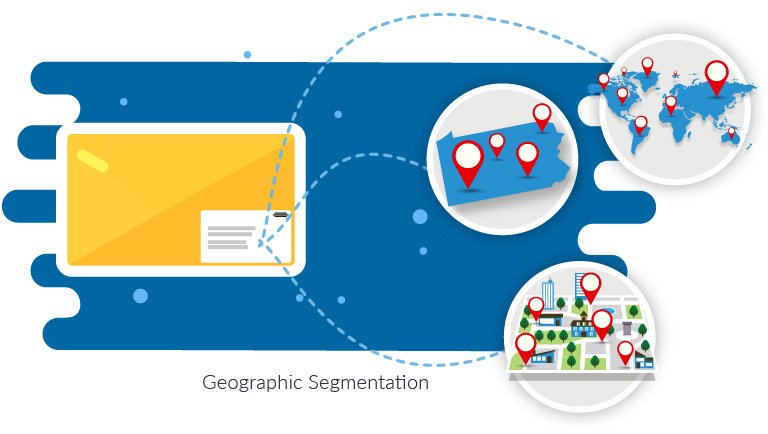
Geographic Segmentation Criteria
- Country
- Region
- State
- City
- ZIP code
- Carrier route
- Neighborhood
- Street
Tips for Using Geographic Segmentation
Target your local audience. Position your business as the go-to spot for prospects to find the products and services they need, rather than driving to the big box store a few towns over.
Send direct mail pieces that correspond with local events. Mailing coupons and timed promotions that correlate with local events, holidays, and traditions increases the relevance and timeliness of your offers.
Know your business limitations. For example, takeout restaurants might only want to mail to homes within 3 miles of their business to avoid orders from outside their delivery range.
Demographic Segmentation (People Stats)
Put simply, demographic segmentation is when you group people together using specific demographic data, like age, gender, and median income. Segmenting individuals based on common traits helps you connect with them on a more personal level because you can craft offers that are more relevant to their lives.
Any business that offers a product or service not everybody can use can benefit from segmenting their audience demographically. This includes beauty companies, home service businesses, luxury brands, and more.
Demographic Segmentation Criteria
- Age
- Gender
- Income
- Race
- Ethnicity
- Marital status
- Household income
- Number of children
- Homeownership status
- And many more…
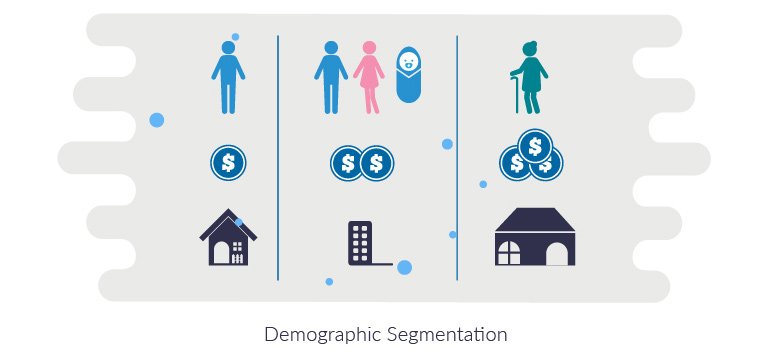
Tips for Using Demographic Segmentation
Pay attention to the details. One of the most common ways businesses use demographic segmentation is to send prospects a special offer for their birthday. This shows them you care and increases the likelihood they’ll visit your business.
Segment audiences by life stage. Studies show that prospects are more likely to try new brands when they enter a new life stage (i.e. marriage, homeownership, and parenthood) and have to shop for products they’ve never bought before. You can also try sending them coupons and special offers for products or services they might need when they move into a new home.
Customize your messaging for different age groups. A beauty company might market their makeup to older women by emphasizing its ability to minimize wrinkles. And when marketing to younger women, they might stress how well it covers blemishes and acne scars. Even though they’re trying to sell the same product, their ad spend goes further because they’re targeting multiple age groups.
Combining Multiple Segmentation Methods
It’s common to use multiple segmentation methods to define your audience. Doing so helps you create specific groups of people who are the most qualified buyers of your product or service. For example, many campaigns combine geographic segmentation with demographic or psychographic data to target audiences who will be most receptive to their offer.
Firmographic Segmentation (Business Stats)
Firmographic segmentation is used with business-to-business (B2B) mailings. Put simply, firmographics are to businesses what demographics are to people. The “firm” in firmographics refers to corporations, LLCs, government agencies, non-profits, and many other business types. Understanding the needs of the business types you want to target helps you determine the messaging and offers they’re most likely to respond to.
Like any other type of audience segmentation, using firmographics to narrow down your audience helps you reach more qualified prospects. It also keeps your messaging relevant and fresh and helps you avoid wasting money targeting companies who can’t use your product or service.
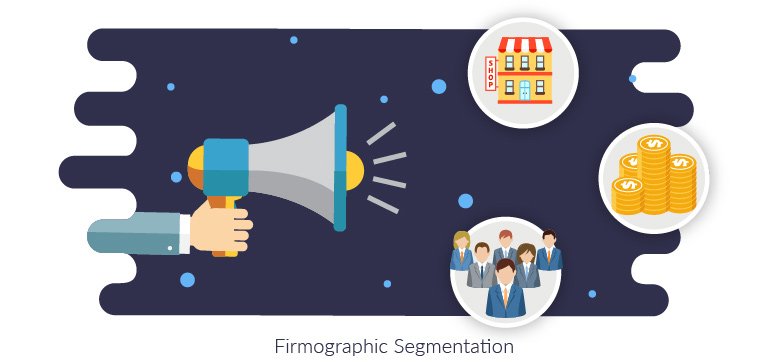
Firmographic Segmentation Criteria
- Employee count
- Revenue
- Industry
- Number of locations
- SIC code
- NAICS code
Tips for Using Firmographic Segmentation
Figure out your audience’s pain points. Break down your prospects based on the type(s) of businesses you want to reach. Try to figure out their unique pain points based on their industry and how your offerings can alleviate those problems.
Look internally when creating offers. Pretend you’re marketing to your own company and consider how you’d want your pain points addressed. This strategy can work with any business type, and you don’t necessarily have to be in the same industry as the company you’re targeting. Instead, focus on the general marketing language and offers that would convince you to give someone your business.
Some B2C companies can use firmographics. Some business-to-customer (B2C) companies can benefit from filtering their audience firmographically. For example, a restaurant might advertise their catering menu to businesses in hopes of getting corporate catering jobs.
Psychographic Segmentation (Hobbies & Traits)
Psychographic segmentation combines psychology with demographics to get a better understanding of your audience. This allows you to use far more specific messaging for groups of people (or individuals) with unique attitudes, personalities, and interests.
Companies offering specialized products that don’t necessarily appeal to a large group of people can benefit most from segmenting their audience psychographically. For example, a fishing equipment company might target fly fishing enthusiasts (psychographics) between the ages of 20 and 40 (demographics) with a customized offer for fishing reels, rather than the general population.
Psychographic Segmentation Criteria
- Values
- Hobbies
- Personality traits
- Attitudes
- Likes and dislikes
- Interests
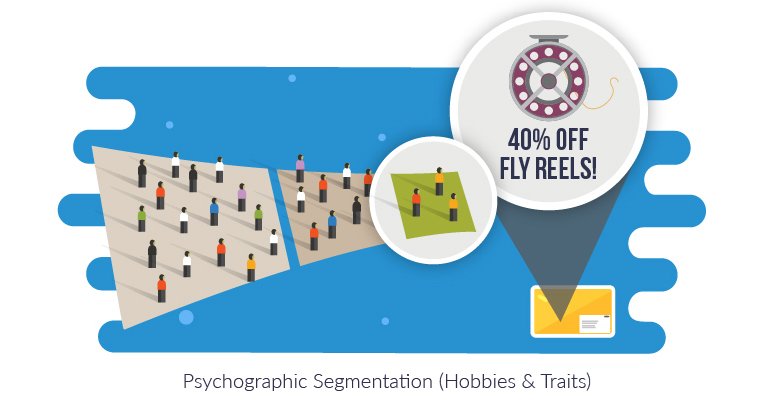
Tips When Using Psychographic Segmentation
Personalize your mail pieces. Make prospects feel like your product or service was custom-made just for them. You can do this by adding personal information to your mail piece, such as their name. Just make sure you don’t get too invasive, as this might make some people feel uncomfortable.
Make the most of consumer data. Take advantage of the wide range of consumer data that’s readily available. You can pay for information from companies like Neilsen and Intelius, or use your own in-house data.
Send surveys to active customers. Reach out to existing customers to assess their values and attitudes in order to group them by shared beliefs. This knowledge helps you learn about your own customers to better target prospects that fit the same criteria.
Sales Stage Segmentation (Customer Status)
Sales stage segmentation takes into account where prospects are in the sales pipeline. Put broadly from top to bottom, these stages are:
-
Awareness – Prospect becomes aware they have a problem.
-
Consideration – Prospect begins gathering information about possible solutions.
-
Evaluation – Prospect begins evaluating different companies and their proposed solutions.
-
Purchase – Prospect becomes a customer.
-
Post-Purchase – Customer becomes a brand advocate.
This type of segmentation helps you stay aware of stages in the buyer’s journey where prospects might need a friendly push. Plus, you can use it to turn inactive customers into active ones if you notice past customers who haven’t ordered from you recently. Ultimately, sales stage segmentation makes it easier to keep tabs on what’s going on with your customers and prospects.
Businesses with the time and money to perform more advanced, granular segmentation should consider filtering audiences by sales stage. Additionally, companies with a lot of data on prospects and customers can easily implement (and benefit from) sales stage segmentation.
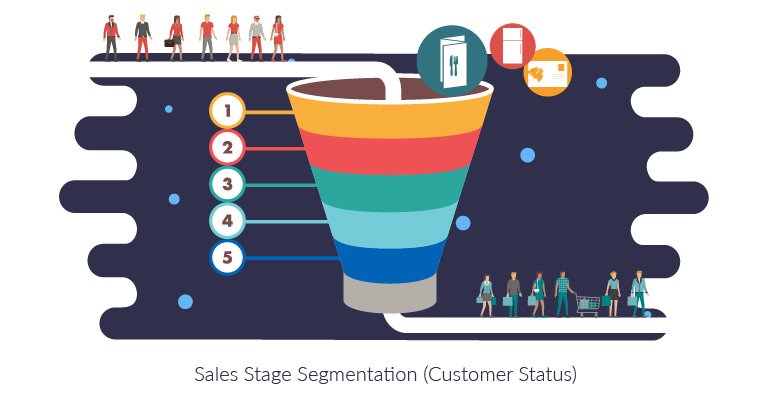
Sales Stage Segmentation Criteria
- Active customers
- Inactive customers
- Prospects
- One-time buyers
- Frequent buyers
- Loyal customers
- Past customers
Tips When Using Sales Stage Segmentation
Don’t forget about loyal customers. Send more personalized pieces to your most loyal customers to increase repeat conversions. Knowing where your customers are in the sales funnel and understanding their wants and needs helps you tailor marketing materials to keep them coming back.
Segment by purchase history. Active customers have proven they’re ready to buy, so you should reach out to them about new and upcoming products or services. Sharing this information can make them feel special and in the know, which increases the likelihood they’ll come back.
Nurture inactive prospects. These individuals need to be wooed and convinced to try what you have to offer. Send them mail pieces specifically tailored to their spot in the funnel, and you’ve got a better shot at bringing them back through your doors. For example, if someone visited your website but abandoned their shopping cart, you could send them a coupon for 20% off and free shipping to entice them to complete that purchase.
Conclusion
Strategically segmenting your audience into smaller groups based on their needs and preferences can benefit any direct mail campaign. And thinking of your customers and prospects not as one large group – but rather as a series of smaller groups – can help you create tempting offers that entice them into action. No matter which type you choose, segmentation can help you reach a more qualified audience to get the most out of your direct mail campaign.
